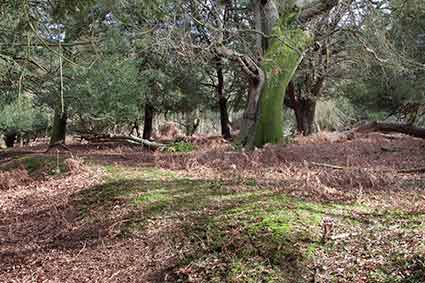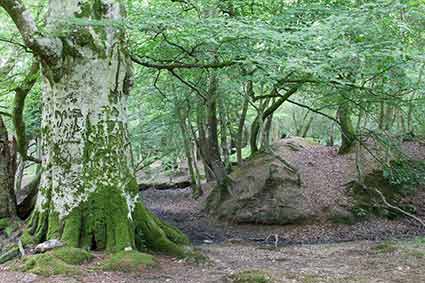New Forest - Royal Hunting Lodges, Medieval Keepers' Lodges and Church 'place' names
(The site of Church Place, Denny, is passed during this 5 mile New Forest walk).

Within the New Forest are a number of places with Church in the name, all a considerable distance away from today's villages. There are Church Places - see below, a Church Moor (A) in Mark Ash Wood and another (B) near Burley, and a Church Green (C).
But these are not the sites of churches, for the names were simply assigned to unexplained earthworks by New Forest folk who had faith in the now discredited belief that William the Conqueror destroyed whole villages, including churches, to make space for his favourite pastime: hunting.
The Churchyard, Sloden (D); Church Place, Denny (E); and Church Place, within Churchplace Inclosure, near Ashurst (F) are all described on modern Ordnance Survey maps as the sites of 'Royal Hunting Lodges'.
Studley Castle (G) - again, the 'Castle' name is a misnomer for this was not a castle at all - near Bramshaw Telegraph, is similarly described; a fifth site, close to Queen Bower (H), near Brockenhurst, is shown simply as the site of a 'Hunting Lodge'; whilst a sixth site, referred to in old documents as Hatheburgh, located at Bolderwood (I), is not shown at all on Ordnance Survey maps.
At all these lodge sites, earthwork remains - traces of earthen banks of varying heights, and ditches, sometimes now obscured by vegetation - can still be seen, although other lodges also existed, including one within the bounds of Lyndhurst Old Park (J), but these have yet to be located, probably because at least some have been destroyed by later forestry operations.
The lodges are frequently considered to be medieval hunting lodges constructed in the 14th or 15th centuries to provide temporary accommodation for visiting royalty or nobility, but the royal connection is sometimes uncertain. However, the cost of building the lodge at Bolderwood - Hatheburgh - was almost three times as much as some of those elsewhere, and it is thought that this is where the King stayed for it had a chapel with royal pew, a great gate and postern, a great chamber for the king, and a long house containing chambers of office including a kitchen, larder, granary and stables. Another lodge - New Lodge, probably on the site of New Park, Brockenhurst (K) - also had accommodation for royalty.
Of the other lodges, Historic England, the public body tasked with protecting the historic environment, when describing Studley Castle, for example, notes: 'Historical records indicate that the original structure was built between 1358 and 1361, that it included a kitchen, and was of timber frame and plaster construction, with a roof of Purbeck and Cornish slates. It formed part of a set of four lodges constructed at the same time in the New Forest for Edward III .... At least three other royal hunting lodges are known to have been constructed in the New Forest during the 13th and 14th centuries'. (The four lodges were Studley Castle, de Parco (within Lyndhurst Old Park), Hatheburgh and Helmesley - the whereabouts of the latter is not known, but it is surely reasonable to assume that it was in the vicinity of Holmsley).
And with reference to Church Place, within Churchplace Inclosure, Historic England says that: 'Documents record that Edward III spent time in the New Forest during the summer of 1366, for which reason repairs were made to several lodges, one of which was referred to as Houndesdoun. The occurrence of a similar name approximately 2km north east of Churchplace and the similarity of the earthworks to other known lodge sites suggest that Houndesdoun and Churchplace refer to the same location'.

And here's Historic England again, this time in the context of the lodge at Queen Bower:
'A document dated to 1428 mentions several royal lodges in the New Forest by name, including one at Queneboure, which is a clear reference to this monument. The document remarks that 'It appears that the said lodges are ruinous, and would have fallen to the ground, but for the expenditure done on them by Thomas earl of Salisbury and count of Perche, keeper of the said forest, out of his own goods'. The result was the issue of a Royal Commission to cut and sell sufficient timber to provide the necessary finance for the repair of the lodges. Contemporary sources record that between 1432 and 1440 a further 200 pounds was spent on the lodges by Richard Clyvedon, who in July 1435 was appointed clerk and surveyor of the king's works in the New Forest'.
At least one of the lodges, then, was timber framed with plaster infill and slate roof. Each was surrounded by earthworks of varying height, or palisades, to provide protection from thieves and other undesirables. The purpose and permanence of some of the lodges has, however, been questioned and there have been suggestions that some were modest structures used by keepers or other Forest officials. For example, after research undertaken at Church Place, Denny, an abstract of a paper presented at the New Forest Knowledge Conference 2017 contained the following:
'While there are many similarities in the layout of the earthworks, there are also some important differences in both the apparent height of the banks and the presence, or absence, of building material that might indicate significant structures. Geophysical survey and excavation of the scheduled site at Church Place, Denny Wait, in 2016 and 2017 suggests that there is greater variety in the nature and function of these sites than has previously been thought. While the archaeological evidence supports the dating of the site, the absence of confirmed structural remains suggests a more ephemeral and perhaps temporary use of the site'.
Which just goes to show that there is still a lot to learn about the New Forest and its past.
References:
Historic England - Church Place, Denny
Historic England - Churchplace Inclosure
Historic England - Studley Castle
Historic England - Queen Bower
Historic England - The Churchyard, Sloden
Historic England - Hatheburgh
Proceedings of the Hampshire Field Club and Archaeological Society, Volume 54 – The Earthwork Remains of Enclosure in the New Forest: Nicola Smith
Excavations at the 'Royal Hunting Lodge' at Church Place, Denny Wait: Abstract and video, Dr Paul Everill, University of Winchester
More links
Other related links
Search this site

Sadly, 58 animals were killed - 35 ponies, 13 cows, 8 donkeys and 2 sheep, whilst a further 32 were injured - 3 pigs, 9 donkeys, 11 cows and 9 ponies.
(Forty-three accidents occurred in daylight, 15 at twilight and 101 in the dark. Twenty-seven accidents were not reported by the driver involved).
Here's just one horrific example - Three donkeys killed in collision with van at notorious New Forest blackspot (Advertiser and Times)

